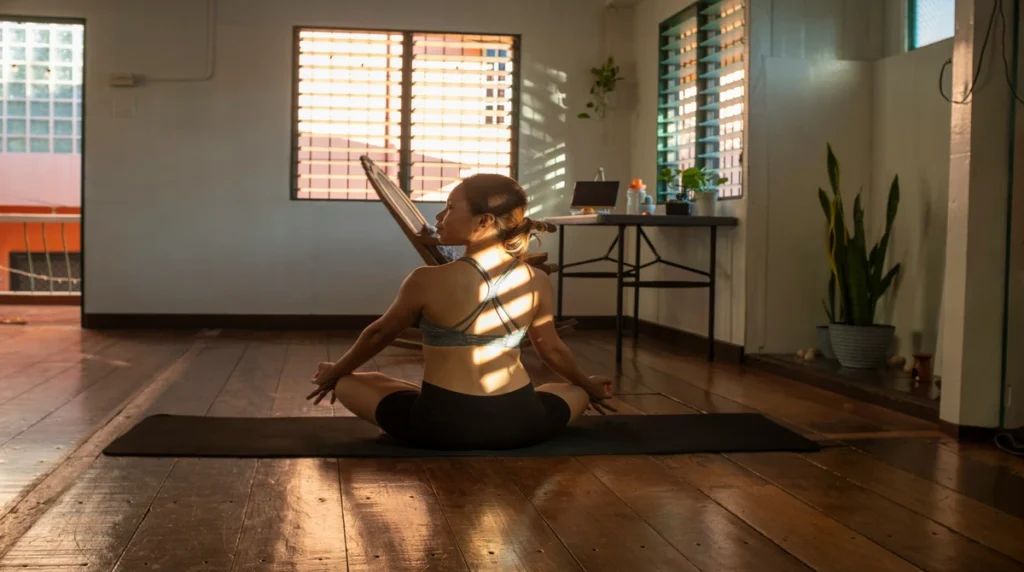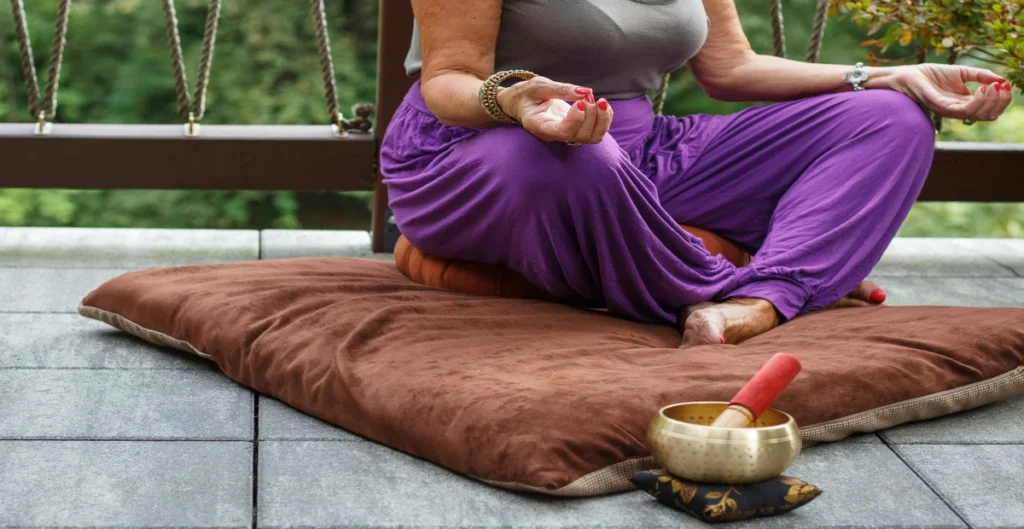Discover basic meditation techniques like focused breathing and body scanning. Learn how to create a serene environment for your meditation practice.
Embarking on a meditation journey can be both exciting and overwhelming for beginners. The art of meditation involves training the mind to focus and redirect thoughts. Beginners can cultivate mindfulness and inner peace by incorporating simple techniques such as focused breathing and body scans.
Establishing a conducive environment free of distractions is crucial for a successful meditation session. Through consistent practice and patience, beginners can experience meditation’s numerous mental, emotional, and physical benefits. This guide will provide step-by-step instructions on starting your meditation practice and developing a deeper connection with your mind and body.

Introduction To Meditation
Meditation is a practice that has gained widespread attention in recent years, as more and more people seek ways to improve their mental and physical well-being. In this introductory guide to meditation, we will explore the rise in popularity of meditation, as well as the potential benefits it offers for your mind and body.
The Rise In Popularity
As our lives become increasingly fast-paced and stressful, many individuals are turning to meditation as a way to find inner peace and balance. With the growing awareness of mental health and self-care, meditation has emerged as a powerful tool for managing stress and promoting overall wellness.
Potential Benefits For Your Mind And Body
Research has shown that regular meditation practice can have a profound impact on both the mind and body. From reducing anxiety and improving focus to lowering blood pressure and enhancing emotional well-being, the potential benefits of meditation are extensive and far-reaching.
Debunking Meditation Myths
Discover the truth behind common meditation myths with “Meditation 101: Techniques for Beginners. ” Learn step-by-step guides to basic techniques like focused breathing and body scan, as well as tips for creating an ideal meditation environment. Start your meditation journey today!
Debunking Meditation Myths:
Meditation is often thought of as a practice reserved for monks or those with hours of free time. However, these beliefs are simply myths that can discourage beginners from trying meditation. In reality, meditation is a simple practice that can be done by anyone, anywhere, at any time. In this section, we will debunk some of the most common meditation myths.
Not Just for Monks:
One of the most common meditation myths is that it is a practice reserved for monks or spiritual gurus. While meditation does have roots in many religious and spiritual traditions, it is not exclusive to those groups. Anyone can practice meditation and experience its benefits, regardless of their beliefs or background.
No Need for Hours of Silence:
Another common myth about meditation is that it requires hours of silence and stillness. While some people do prefer longer meditation sessions, it is not necessary to meditate for hours to experience its benefits. Even just a few minutes of focused breathing or a body scan can help to reduce stress and increase mindfulness.
To get started with meditation, it is important to find a technique that works for you. One simple technique is focused breathing, where you simply focus on your breath and let your thoughts pass by without judgment. Another technique is a body scan, where you focus on each part of your body and notice any sensations or tension.
Creating a Conducive Environment:
To make the most of your meditation practice, it can be helpful to create a conducive environment. This could mean finding a quiet space to meditate or using props like cushions or blankets to make yourself comfortable. It can also be helpful to set an intention for your meditation practice, whether it is to reduce stress, increase focus, or simply be present in the moment.
In conclusion, meditation is a simple practice that can be done by anyone, anywhere, at any time. By debunking common meditation myths, we can encourage beginners to try meditation and experience its benefits. Whether you prefer focused breathing or a body scan, finding a technique that works for you can help to reduce stress and increase mindfulness.
Choosing The Right Meditation Style
When it comes to meditation, there are various techniques and styles to choose from. Each style offers its own unique benefits and approaches to achieving a calm and focused state of mind. Finding the right meditation style for you is essential to ensuring a fulfilling and effective practice. In this section, we will explore three popular meditation styles: Mindfulness Meditation, Guided Visualization, and Mantra Meditation. Let’s dive in!
Mindfulness Meditation
Mindfulness meditation is a technique that focuses on cultivating a heightened awareness of the present moment. It involves observing your thoughts, sensations, and emotions without judgment. By practicing mindfulness, you develop the ability to stay grounded and fully engaged in the present, rather than dwelling on the past or worrying about the future.
Here are some key points to remember about mindfulness meditation:
- Find a quiet and comfortable place to sit or lie down.
- Close your eyes and take a few deep breaths to relax your body.
- Bring your attention to the sensation of your breath, noticing the inhales and exhales.
- If your mind wanders, gently redirect your focus back to the breath without judgment.
- Continue this practice for a few minutes or as long as you desire.
Guided Visualization
Guided visualization is a meditation technique that uses the power of imagination to create a soothing experience. It involves listening to a recorded script or a meditation teacher guiding you through a visual journey. By engaging your senses and imagining peaceful scenes, you can relax your mind and body, reducing stress and promoting overall well-being.
Here are some tips to enhance your guided visualization practice:
- Find a quiet and comfortable space where you can fully relax.
- Choose a guided visualization recording or use your imagination to create your visualization.
- Close your eyes and focus on the guidance, allowing your mind to create vivid images.
- Engage your senses by imagining the sights, sounds, smells, and sensations of your chosen visualization.
- Allow yourself to fully immerse in the experience and let go of any stress or tension.
Mantra Meditation
Mantra meditation involves the repetition of a word, phrase, or sound, known as a mantra, to calm the mind and enhance focus. The mantra serves as a point of concentration, allowing you to let go of distracting thoughts and enter a state of deep relaxation. This technique has been practiced for centuries and is known for its ability to promote mental clarity and inner peace.
Here’s how you can practice mantra meditation:
- Choose a mantra that resonates with you. It can be a traditional Sanskrit mantra or a simple word or phrase in your native language.
- Sit in a comfortable position and close your eyes.
- Take a few deep breaths to center yourself.
- Start repeating the mantra silently or aloud, focusing your attention on its sound and vibration.
- If your mind wanders, gently bring your focus back to the mantra.
- Continue this practice for a set amount of time or until you feel a sense of calm and tranquility.
Remember, choosing the right meditation style is a personal journey. It’s important to explore different techniques and find what resonates with you the most. Whether you prefer mindfulness meditation, guided visualization, or mantra meditation, the key is to establish a regular practice that fits seamlessly into your lifestyle. Happy meditating!
Setting Up Your Meditation Space
Create the perfect meditation space with our step-by-step guide. Learn basic techniques like focused breathing and body scan, while discovering tips for creating a conducive environment for your meditation practice. Transform your space into a tranquil oasis for inner peace and mindfulness.
Setting up your meditation space is an essential step in creating a conducive environment for your practice. By carefully curating your meditation space, you can enhance your focus, relaxation, and overall experience. In this section, we will explore two key aspects of setting up your meditation space: creating a calming atmosphere and gathering essential tools and accessories.
Creating a Calming Atmosphere:
To create a calming atmosphere in your meditation space, consider the following tips:
1. Choose a quiet location: Find a spot in your home where you can minimize distractions and interruptions. Ideally, select a room or corner where you can have some privacy and peace.
2. Declutter and clean: Remove any unnecessary items or clutter from your meditation space. A clean and organized environment can help promote a sense of serenity and tranquility.
3. Natural lighting: If possible, allow natural light to fill your meditation space. Natural light can create a soothing ambiance and promote a sense of connection with the outside world.
4. Soft colors: Opt for soft, neutral colors on the walls and furnishings in your meditation space. Colors like light blue, pale green, or cream can help create a serene and calm atmosphere.
5. Aromatherapy: Consider using essential oils or incense to add a pleasant aroma to your meditation space. Scents like lavender, sandalwood, or chamomile can promote relaxation and enhance your meditation experience.
Essential Tools and Accessories:
In addition to creating a calming atmosphere, gathering the right tools and accessories can enhance your meditation practice. Here are some essentials to consider:
1. Meditation cushion or mat: A comfortable cushion or mat can provide support for your body and help maintain a proper posture during meditation. Choose one that suits your preference and ensures a comfortable sitting position.
2. Blanket or shawl: Having a blanket or shawl nearby can provide warmth and coziness during longer meditation sessions or if you tend to get chilly easily.
3. Timer or meditation app: Set a timer or use a meditation app to track your meditation sessions and keep you on track. This can help you stay focused and avoid the distraction of constantly checking the time.
4. Mindfulness bell or chime: Using a mindfulness bell or chime can serve as a gentle reminder to bring your attention back to the present moment. The sound can help anchor your awareness during meditation.
5. Sacred objects or symbols: Consider placing meaningful objects or symbols in your meditation space. These can be religious or spiritual items, crystals, or personal items that hold significance for you. They can serve as reminders of your intentions or beliefs.
By setting up your meditation space with a calming atmosphere and gathering essential tools and accessories, you can create an environment that supports your meditation practice. Experiment with different elements to find what resonates with you and enhances your overall experience.
Meditation Postures For Beginners
Meditation postures play a crucial role in establishing a comfortable and focused practice for beginners. Finding the right position can significantly impact the effectiveness of meditation. Here are some essential meditation postures for beginners to consider:
The Classic Lotus Position
The lotus position, also known as Padmasana, is a traditional meditation posture that involves crossing the legs and placing each foot on the opposite thigh. This pose encourages stability and helps maintain an upright spine, essential for deep breathing and concentration during meditation.
Comfortable Alternatives
For beginners who find the lotus position challenging, there are several comfortable alternatives to consider. Sitting cross-legged on a cushion or mat can provide the necessary support and stability. Additionally, kneeling with the aid of a meditation bench or using a straight-backed chair can offer a suitable alternative posture for meditation.

The Art Of Breathing
Learn the art of breathing with our beginner’s guide to meditation. Discover techniques like focused breathing and body scans, and tips for creating a calming environment. Start your journey towards inner peace today.
Understanding Breathwork
The art of breathing is fundamental in meditation. It helps center your mind and body, promoting relaxation and focus.
Simple Breathing Exercises
Focused Breathing: Inhale deeply through your nose, hold for a few seconds, then exhale slowly through your mouth.
Body Scan Technique: Inhale, directing your breath to different body parts, noticing sensations as you exhale.
Conducive Environment: Find a quiet, comfortable space with minimal distractions for your meditation practice. Use cushions or a mat for added comfort.
Benefits of Breathwork: Enhances mindfulness, reduces stress, and promotes mental clarity.
Consistency is Key: Practice these techniques regularly to experience the full benefits of meditation.
Incorporating Meditation Into Daily Life
Incorporating meditation into daily life is essential for beginners to establish a consistent practice. By integrating short sessions into busy schedules and meditating while commuting, you can seamlessly make meditation a part of your routine.
Short Sessions For Busy Schedules
When: Before or after work, during lunch breaks.
How: Set a timer for 5-10 minutes. Find a quiet spot.
- Focus on your breath.
- Release stress.
- Recharge your energy.
Meditation While Commuting
Utilize commute time for meditation.
Focus on your breathing or body sensations.
- Close your eyes.
- Tune into your surroundings.
- Stay mindful.
Overcoming Common Challenges
Overcoming common challenges is an essential part of establishing a successful meditation practice. Understanding how to deal with distractions and staying motivated can make a significant difference in your journey towards inner peace and mindfulness.
Dealing With Distractions
Identify distractions like noise or thoughts. Redirect focus back to breathing or body sensations.
Staying Motivated
Set small, achievable goals. Celebrate progress and be consistent with your practice.
Tracking Your Progress
Evaluating your progress in meditation is essential for growth. Keep a journal to track your experiences, emotions, and insights after each session. Reflecting on your journey can help you stay motivated and committed to your practice.
Tracking Your Progress
Journaling Your Journey
Noticing Subtle Changes
Tracking your meditation progress is essential for growth and consistency.
Journaling Your Journey
Keep a journal to record your thoughts and experiences.
Noticing Subtle Changes
Be mindful of even the smallest shifts in your practice.
Further Resources And Learning
Books And Apps For Beginners
For those looking to deepen their meditation practice, there are several excellent resources available in the form of books and apps. These resources can provide valuable guidance and support for beginners as they embark on their meditation journey. Here are some highly recommended options:
- The Mind Illuminated by John Yates
- Headspace app
- Calm app
Local Meditation Groups And Classes
Joining a local meditation group or enrolling in meditation classes can offer a supportive and enriching experience for beginners. It provides an opportunity to connect with like-minded individuals and receive guidance from experienced instructors. Here are some ways to find local resources:
- Search online for meditation groups in your area
- Inquire at local community centers or wellness studios
- Check for listings in community event calendars
Frequently Asked Questions
What Are The Benefits Of Meditation For Beginners?
Meditation can reduce stress, improve focus, promote emotional health, and enhance self-awareness. It can also help in controlling anxiety, enhancing self-awareness, and improving sleep.
How Can Beginners Practice Focused Breathing Meditation?
Find a quiet place, sit or lie down, and take slow breaths. Focus on the sensation of breathing and gently bring back the focus if the mind wanders. Start with 5-10 minutes daily.
What Is A Body Scan Meditation And How To Do It?
Body scan meditation involves focusing on each part of the body, starting from the toes to the head. Lie down, close your eyes, and bring awareness to each body part, releasing tension as you go.
Conclusion
Meditation can be a powerful tool for reducing stress and improving overall well-being. By practicing basic techniques like focused breathing and body scans, beginners can establish a foundation for regular meditation practice. Creating a conducive environment, such as finding a quiet space and minimizing distractions, can also enhance the experience.
With dedication and consistency, anyone can benefit from the positive effects of meditation in their daily life.



